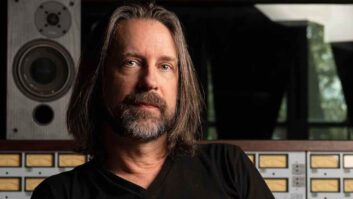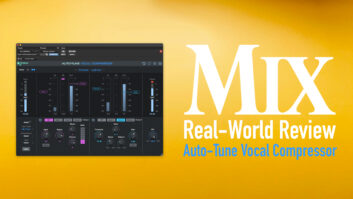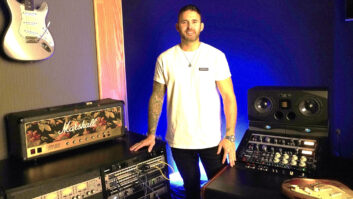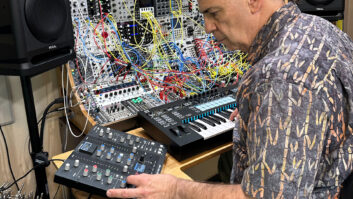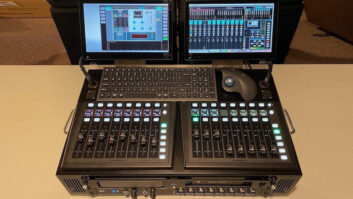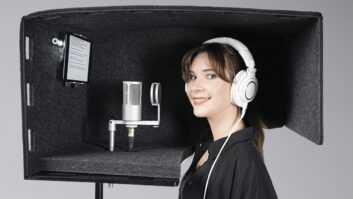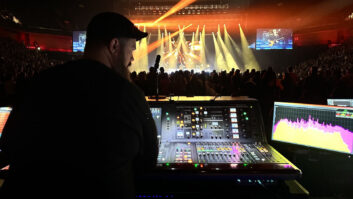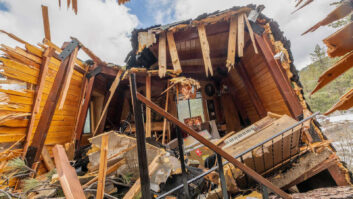Chris Boyes knows dinosaurs. He knows how they walk, how they look without digital skin, how they bellow in fear or anger or joy. He knows the differences between a carnivore’s salivating growl and a leaf-eater’s quiet chew. And he should, because he has been directly or indirectly responsible for most of the sounds in the dinosaur craze throughout the 1990s, starting with Jurassic Park, where he recorded most of the original sounds that were later designed by Gary Rydstrom, followed by an assistant sound designer credit on The Lost World. For the past two years, with breaks during which he worked on Titan AE and a number of other design/mix projects, he worked up vocals for iguanodons, raptors, brachiasaurs and the like for Disney’s hugely anticipated spring release, Dinosaur.
“It’s deceiving, because you’re not going to hear two years’ worth of effects on the screen,” Boyes laughs from his edit suite at Skywalker Sound. “It was more about the process, with issues that were addressed and resolved over that two-year period. Disney would give me shots in progress to work on, and once a week I’d fly down to Burbank to play them tracks. The first concept was that they wanted Aladar, our hero, to speak like a big dinosaur but in a rhythmic fashion that would give him a signature quality of a lemur.”
As the movie opens, Aladar, still inside the egg, is separated from his parents during a raid by the T-Rex-like Carnotaur. A pterodactyl scoops up the egg to bring home for feeding, but loses it along the way and it ends up on Lemur Island, where Aladar is hatched and raised. During a comet storm, he must make it back to the mainland, eventually linking up with the dinosaur herd on a long trek to the sanctuary of the mating ground, dodging raptors and Carnotaur on the way.
After establishing the basic lemur vocalizations, Boyes tried to fit elements into Aladar but found they didn’t really work. Instead, he let Aladar be a dinosaur, with the compromise being that he would be more melodic and vocal than his brethren. “The big challenge on Dinosaur was to create a series of languages,” Boyes says, “evoking emotions that were everything from joyful and happy, to mournful and sad. With the human language, we can inject emotion very easily, but to try to do that by twisting sounds that originally came from animals was a challenge and perhaps the most difficult part of the film.”
The early part of the film takes place on Lemur Island, where life is good and the comet hasn’t yet rained destruction. Boyes tried using real lemur calls, but found them too mournful to be twisted into something joyful. “So I used a combination of penguins, a fox named Socks the Fox, and capuchin [monkeys]. The penguins had these wonderful whoops that worked well for movement, a jumpy kind of excited call. The capuchins were tremendously vocal and rattled off all sorts of little chirps. And Socks the Fox made these wonderful mournful yips and yaps that I was able to use both for happy and sad lemur. Then there’s a wonderful scene, during mating season and just prior to the comet falling, where they’re coming into the camera and have these happy bellows. For some of those key calls, I ended up with human voices-one of my Foley editors.”
Boyes, who edits in Pro Tools, relied on his Synclavier for design. “I’m making thousands of sounds,” he says, “and you have to quickly figure out at what pitch the penguin fits with the capuchin. If I lead with the penguin, at what point do I come in with the fox? You’re able to establish that arrangement on the Synclavier in a very natural, phonetic and musical way.”
While Aladar’s vocals and the lemur language were meant to signify community and a wide range of emotions, the vocals for the raptors and Carnotaur-though equally complex-were built primarily to inspire terror.
The basis of the raptors ended up being a 10-year-old Chihuahua with emphysema, which offered trills and growls and more than a bit of the menace. Boyes then layered in goose hisses and yellow-blackbird caws. “It worked well when the raptors are grouping together and surrounding their prey,” he says. “There’s a wonderful sequence when we first meet up with the raptors and you’re lulled into thinking, ‘These aren’t bad creatures. We can make friends with them.’ And they go from inquisitive and curious suddenly to these vicious creatures who want to rip our hero to shreds.”
Boyes gives much of the credit for the dinosaur vocals to his recording team, including assistant sound designer Beau Borders and field recordists Scott Guitteau and Kathy Turco. Early on, Borders went to Florida for some field recording and came back with, among other things, a leopard sound that became the basis for the vicious, carnivorous Carnotaur.
“We called that ‘pissed leopard,'” Boyes laughs, “because this guy was angry. Beau got some great recordings-real close, guttural, wet snarls and breaths and chuffs. In the first scene, Carnotaur is hidden in the forest, and he’s breathing subtly and dripping, oozing liquid. It was very important to the director that he be wet and salacious. His salivary glands are in overload, and all he could think about was, ‘Eat this thing.’ So the pissed leopard with an elephant combination became this ethereal, regal, growling sound. Once he breaks out of the forest, I use the leopard with a pig sound-I think it’s a large boar-and a macaw. The combination of those three gives a high shrieking element with a real feel for terror.”
The film overall offers a unique visual feel, with traditional and computer-designed animation integrated into real backgrounds (themselves digitized and manipulated). Sounds that Boyes recorded while on vacation in Hawaii provided the lushness for Lemur Island, while many of the wind techniques he honed working on Titanic proved useful once the dinosaurs embarked on the long trek through the desert.
“We end up in the desert for a long time,” Boyes says, “and I wanted to keep it interesting. There’s a sandstorm, which was fun to design and edit, with the winds rushing and Foley putting in some great particle sounds. There’s night sequences where we play with processed crickets. And there’s daytime, where the winds allow you to create this incredible spatial quality so that you feel like you’re in this vast, wide open area. There was very little to echo off of, and there was very little life, other than the herd itself. A lot of the initial sound design I did that [Disney] didn’t buy off on for specific characters, we were able to use for herd. We created a background of group walla, of dinosaur sounds, that read specific creatures and mass of creatures. In a way, the herd became the most interesting background of this film. Music is big at that point, so the herd pokes through.”
Frank Eulner came on as supervising sound editor about a year into the project. Ethan Van der Ryn, fresh off Saving Private Ryan, cut the big opening and closing battle sequences, as well as the comet firestorm. Boyes, who usually mixes the films he designs, premixed the effects with Dean Zupancic on the Neve DFC at Skywalker. The stems were brought down to the main stage at Disney on Tascam MMR-8 drives, with original elements on Pro Tools drives. The re-recording team of Terry Porter on dialog, Zupancic on effects and Mel Metcalfe on music mixed on a Harrison console, with two Otari sidecars and Flying Faders automation.
